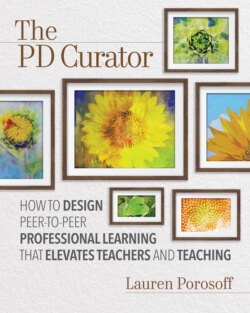Читать книгу The PD Curator - Lauren Porosoff - Страница 9
Making Time for Peer-to-Peer PD
ОглавлениеWhen I started working at a school we'll call the Isidore Topial School, I was excited to learn that teachers met often in different configurations. In the middle school division, most of us taught four sections of the same course, which meant we had to prepare just one set of lessons and assignments. That freed up time to give more substantive feedback on student work, give extra help to students who needed or wanted it, talk to parents, and meet with one another.
Our weekly schedules included two grade-level team meetings during school hours. One was called "student review" because we discussed individual students about whom we had concerns, shared strategies that worked for them, and developed plans for supporting them further. The other meeting had no special title (although in the early years, it was called nonstudent review). At those meetings, we planned for our advisory periods, field trips, guest speakers, family conferences, and anything else we did as a grade level outside our academic classes. Over time, as those programs became more entrenched, we stopped feeling like we needed that second meeting and eventually discontinued it.
In addition to the grade-level meetings, we also had one weekly after-school meeting where the full faculty came together to hear presentations or have discussions in small groups. Occasionally, we met with our colleagues who taught the same subject at department meetings, the agendas for which department chairs had the autonomy to set. During these meetings, the group would make decisions (such as whether to order new materials), discuss schoolwide initiatives (such as how we planned to use a summer book within our content area), or plan for future instruction (such as how to teach about an upcoming election).
Topial also had two in-service days per year, which was when we could come together with teachers from the elementary and high school divisions (though we didn't always do that). Beyond attending these mandatory meetings, many teachers chose to meet in various configurations. For example, when I taught 6th grade English, I frequently met with the other 6th grade English teacher. I also volunteered for various committees and task forces.
Although Topial had an ideal structure for peer-to-peer professional learning, we rarely engaged in it during our meetings. Some team leaders and department chairs tried, but they either didn't do it often enough (or meet often enough) for the learning to feel routine, or they faced resistance because they were perceived as pushing their own agendas. If one 7th grade team leader asked her team to keep meeting twice a week to do PD together but another team leader only met once a week, it felt unfair. There were even teachers who approached our union reps to ask if they had to attend what they perceived as extra meetings when they were already going to so many—most of which felt unnecessary. Sometimes it seemed as if the only thing we did more often than go to meetings was complain about them!
There will always be people who simply don't want to do what they perceive as more work. For many of us, though, the issue was the meetings' content rather than their frequency. We attended lots of meetings to hear information that could have been relayed in emails. We talked about the same students repeatedly without changing our methods of intervention, let alone our curricula or pedagogies. We listened to out-of-touch guest speakers tell us things we already knew or that wouldn't work at our school. We listened to administrators blame and shame us without reflecting on their own practices—or worse, they offered vague praise without appreciating the excellence within our ranks. We listened to the same few white people pontificating. So many meetings were a waste of time at best.
At one point, frustrated by all those meetings, we (ironically) organized our own meeting to come up with better ways to use all that meeting time! We brainstormed topics we wanted to explore together. Although our principal told us we could form professional learning groups, he made attendance mandatory and the work itself directionless. That satisfied no one; those who thought there were already too many meetings felt like the learning groups just added to their workload, whereas those who wanted to do more purposeful PD felt like they were designed to appeal to the lowest common denominator and appease an angry faculty. In the end, our grassroots attempt at in-house PD faded away—like so many other initiatives.
For our purposes, we can learn two lessons from my former school's numerous meetings:
No matter how often teachers meet, it's important to prioritize peer-to-peer professional learning during those times. That doesn't mean every meeting must be used that way, but the more time you devote to PD, the more actual learning you make possible—and the more meaningful those meetings feel.
If you want to do peer-to-peer professional learning, you need to build time for it into the schedule and calendar. That doesn't mean the only way to do this work is the way my former school did, by having teachers meet three times per week, plus twice a year for in-service days. But the more time you allocate for teachers to meet with one another, the more time you have for PD.
